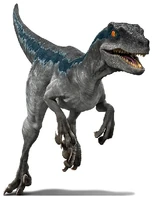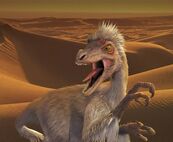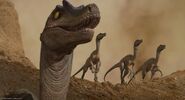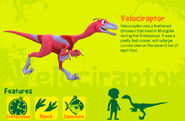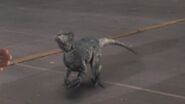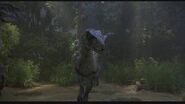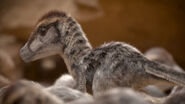| Velociraptor Temporal range: Late Cretaceous | |
|---|---|
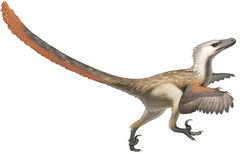
| |
| Fred Wierum's illustration of Velociraptor mongoliensis | |
| Scientific classification | |
| Kingdom: | Animalia |
| Phylum: | Chordata |
| Class: | Sauropsida |
| clade: | Dinosauria |
| Suborder: | Theropoda |
| Family: | †Dromaeosauridae |
| Subfamily: | †Velociraptorinae |
| Genus: | †Velociraptor Osborn, 1924 |
| Type species | |
| †Velociraptor mongoliensis Osborn, 1924 | |
| Referred species | |
| |
Velociraptor (ve·loc·i·rap·tor) (Latin meaning "swift thief") was a small carnivorous dinosaur, well known, thanks to Jurassic Park. It was one of the smaller dromaeosaurs, smaller than Utahraptor and Deinonychus, and was about 2 meters long. It lived in South Korea, Mongolia and China during the Late Cretaceous, 80 - 70 million years ago. Fossils found in 2007 show that Velociraptor had long feathers on its forearms.
General Description[]
Velociraptor was a small theropod, with a large sickle-shaped claw on the second toe of its foot, and had a long, narrow, upturned snout, which is different from the other members of its family. The jaws were lined with serrated teeth for tearing flesh, it swallowed its food in gulps instead of chewing, like most theropods. The arms were long and it had strong chest and arm muscles, for grasping onto prey.
Like other dromaeosaurs, it had a falcarian claw on the second digit of its foot. This was raised off the ground, which can be seen in footprints of itself and other related dinosaurs.
Another dromaeosaurid feature that can be clearly seen in the death-pose are the long pieces of bone along the sides of the bones of the tail to stiffen it. This allowed the tail to act as a balance when the animal walked and ran. While this stiffened the vertical mobility, the tail could still swing side to side, possibly acting as a rudder during gliding.
Discovery[]
In 1922, the first specimen of Velociraptor mongoliensis (AMNH 6515) was found by the American Museum of Natural History. It was found in the Late Triassic sandstones of the Djadokhta Formation in the Gobi Desert, and was also found lying alongside a skull of Protoceratops.
Fighting Dinosaurs[]
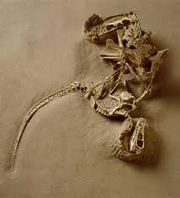
The "Fighting Dinosaurs" fossil
The most famous find in Mongolia may be the discovery of the skeletons of the small theropod V. mongoliensis with its right arm clamped firmly in the beak of the small sheep-sized ceratopsian Protoceratops andrewsi (GIN 100/25). Both were fighting when a sand dune collapsed, killing the two dinosaurs and preserving them in their death pose until 1971, when they were unearthed by a Polish-Mongolian team.
The foot claw of the Velociraptor has been embedded into the neck of the Protoceratops, while the right arm of the Velociraptor has been bit and broken by the Protoceratops. This suggests they were either fighting or had fatally injured each other, before being buried.
It is considered a national treasure of Mongolia.
Diet[]
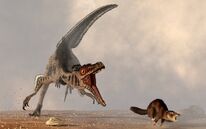
Velociraptor chasing a small mammal by Daniel Eskridge
Velociraptor was a carnivore who probably ate anything it could capture, sense its size was slightly larger than a turkey, the most likely prey were small mammals and dinosaurs.
Some of the Velociraptor skeletal remains have been found in close proximity of each other, which led scientists to believe that Velociraptor probably hunted in packs; however, they have also been interpreted as being congregations similar to scavenging komodo dragons, or nesting birds. They used their front claws to capture and hold their prey while they ate.
Since the Fighting Dinosaurs specimen was found with a Protoceratops, it probably ate this small ceratopsian, but it may have hunted even larger prey. Its diet also included small animals, such as lizards.
Birth and Offspring[]
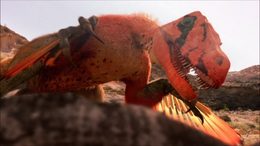
Velociraptor as it appeared in Dinosaur Revolution
We have no clear evidence that Velociraptor hatched from eggs. According to paleontologist David Burnie, it's quite possible that Velociraptor gave birth to live young. The female pelvis is very wide, which may be evidence for this theory. Despite this, fossilized skulls of Velociraptor young were recently found. Looking at them, we determined
young Velociraptors had proportionally shorter snouts and bigger eyes than the adults, what's very usual for avian animals, such as Velociraptor. This indicates that the babies were fed and looked after by the adults for some period after hatching. However, some modern reptiles like turtles also have these skewed proportions, so they could equally be related to simply sense and ecology, with large eyes favoring nocturnal vision. Based on other Deinonychosaurs, Velociraptor was probably precocial, meaning that, even if it had parental care, it was very capable of moving around and finding it's own food in its lifetime.
Senses[]
Velociraptor had a fairly large brain, compared to other dinosaur species, which made them fairly intelligent compared to other non-avian theropods. However, their intelligence was still not above that of modern "basal" birds like ostriches and geese.
The study of dinosaur skulls demonstrates that the Velociraptor had excellent hearing and binocular vision. All dinosaurs have a notch in their skull and middle ear bones where the tight ear drum stretched. Crocodiles and birds, both of which are related to the dinosaurs, have a keen sense of hearing, so it is not surprising that dinosaurs also had an acute sense of hearing. Nerve endings around the outside of the Velociraptor’s skull and the large olfactory lobes, suggests that the dinosaur's snout was highly sensitive to touch and smells. The Velociraptor like other predators had binocular vision, which allows them to see with good depth perception.
Velociraptor in pop culture vs the actual Velociraptor[]
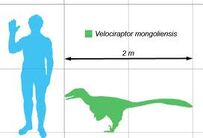
Velociraptor size comparison by Serenthia [1]

Male and female Velociraptors from Jurassic Park III
Velociraptor was a member of the Velociraptorinae subfamily, and grew no larger then 2.07m long. Unlike its film counterpart portrayed in the movie ‘‘Jurassic Park’’.
The Velociraptor in 'Jurassic Park' is much larger than the fossil record would indicate (standing 8–10 feet/2.43-3.048 meters tall and 4.25–6 meters long). It loosely resembles an outdated depiction of Deinonychus, a North American dromaeosaurid in the eudromaeosauria subfamily, more than it does Velociraptor.
This was due to the animal being based upon a Deinonychus, because Deinonychus remains had been attributed to the now dubious "Velociraptor antirrhopus", which would later erect the name "Deinonychus". The so-called 'raptor' in the movie is more similar to a Utahraptor or Deinonychus in size while the real Velociraptor was roughly the size of a turkey.
The Dromaeosaurids in the 'Jurassic Park' series also lack feathers and are bigger; instead of feathers, they are given squamas on their backs. The reason for the differences may be the result of genetic splicing errors and the utilization of amphibian DNA to fill in the genetic code sequence gaps, as well as the fact that it was not widely known that non-avian dinosaurs had feathers at the time of the original films making.
Note: In canon, Jurassic World and Jurassic Park designed most dinosaurs to have no feathers and engineered the Velociraptors to be larger than normal.
But in real life Michael Crichton called the Deinonychus a Velociraptor because his team thought Velociraptor "sounded cooler".
In the Media[]
- Along with Tyrannosaurus rex, Velociraptor is popular in films and documentaries due to its infamy in the Jurassic Park series. It is featured in all of the Jurassic Park & Jurassic World movies, especially the first and the second Jurassic World movie, where they are known not to attack, and, instead, are trained to “protect” people. The four Velociraptors were named Blue, Delta, Echo & Charlie, by their trainer, Owen Grady, with Blue being the only survivor. Later on, in Dominion, Blue gives offspring asexually leading to a new raptor for the franchise. This new raptor, called Beta, is colored exactly like blue and is kidnapped by poachers, kicking off the plot.
Blue The Velociraptor from Jurassic World: Camp Cretaceous

Jurassic World ‘‘Charlie’’ Velociraptor
- Velociraptor is the first dinosaur seen in Jurassic Park. The first scene features a raptor being transported into the paddock. In the second half of the movie, the raptors break out of their pen and are the main threat that stands between the humans and their means of escaping the island.
- In the second movie, The Lost World: Jurassic Park, a Velociraptor pack inhabits the abandoned village on Isla Sorna. The humans, who are stranded on the island, have to run and fight their way through the raptors to reach the phone in the village and reach the helicopter. Nearly all of the Velociraptors (save for one) in this film are more brightly colored compared to the completely brown raptors in the first film. This is never explained in the film itself, but behind the scenes material has stated that the colored raptors were the males of the species.
- Velociraptor is shown in Dinosaur King.
- Velociraptor is featured in Dinosaur Train.
- In Jurassic Park III, the raptors have more varied colors. The males are colored purple with a very light bluish stripe along their back and red spots on their nasal ridges. The males of these raptors had quills on the top of their heads, but the females don't. The females are white-light gray with black spots. In general they had crests with more elongated and pointed skulls. The raptors are stalking the humans to retrieve their stolen eggs.
- In Jurassic World, Jurassic World: Camp Cretaceous, Jurassic World: Fallen Kingdom, and Jurassic World: Dominion, the raptors are now in different colors. Blue, and her daughter, Beta, has bluish-gray skin with a white stripe with metallic blue in the middle going horizontally from her eye orbit, with one side has blue around the eye, while the other side’s stripe stop so at the head, down to the tip of her tail which the LEGO website states comes from the DNA of the black-throated African monitor lizard (Varanus albigularis microstictus) used in her creation. Echo is brown with dark blue striping as well as having dark blue around her eyes. The most noticeable trait is the scar on the left side of her muzzle. Charlie is green with black vertical stripes running down her back. Delta is a teal color, with no stripes on her back or tail. Charlie looked similar to Delta, except Charlie was a darker light green with black stripes.

- A large pack of Velociraptors appeared in the movie Dinosaur 2000, attacking the main character Aladar.
- A pack of Velociraptors have been seen attacking an ice cream truck in the 2009 movie, Land of the Lost.
- Velociraptor appeared in Dinosaur Planet, with the main raptor being a female named White Tip.
- The same Velociraptors from the Jurassic Park movie have been appeared in the Jurassic Park Telltale game.
- The featherless Velociraptors appeared in Chased by Dinosaurs and later in Sea Monsters.
- One Velociraptor appeared a cameo in Primeval Season 3.
- Velociraptor appeared in Dinosaur Revolution, with red feathers all over it's body. They killed a mating pair of Protoceratops, and attempted to kill their child, only for a lone bull to scare the raptors off and take the child to another herd.
- Velociraptor appeared in the recently-made documentary series, Prehistoric Planet, with a major role in the two episodes it appears in, Deserts and Freshwater, and later, in the second season, Badlands.
- Velociraptor was added to Prehistoric Kingdom in update 8.
Gallery[]
References[]
- 1 .General Description credits to RomTech Computer CD Rom Dinosaur Discovery
- 2. Birth and Offspring - Concise Dinosaur Encyclopedia (David Burnie)
- http://www.amazon.com/Concise-Dinosaur-Encyclopedia-The/dp/0753457547
- https://books.google.com.tr/books?id=5J2-YvesgyUC&pg=PA10&lpg=PA10&dq=Velociraptor&source=bl&ots=pM_plMz18b&sig=ACfU3U3H_Q-VxOvI5NZq9kIlqJ6wELqxVA&hl=en&sa=X&ved=2ahUKEwj334qGxej1AhWrSPEDHb8UDvIQ6AF6BAhQEAM#v=onepage&q=Velociraptor&f=false
- https://books.google.com.tr/books?id=fjba7Sf_QjYC&pg=PA3&lpg=PA3&dq=Velociraptor&source=bl&ots=xgbOBdcdqP&sig=ACfU3U026vUcsgoEBJ4RMqBN02HK-u-ClQ&hl=en&sa=X&ved=2ahUKEwj334qGxej1AhWrSPEDHb8UDvIQ6AF6BAhSEAM#v=onepage&q=Velociraptor&f=false
- https://books.google.com.tr/books?id=7_Xpl4tkVkUC&pg=PT45&lpg=PT45&dq=Velociraptor&source=bl&ots=q8WvpwBhBJ&sig=ACfU3U35kig5pYS9IngsseNU3VgQj1of0Q&hl=en&sa=X&ved=2ahUKEwj334qGxej1AhWrSPEDHb8UDvIQ6AF6BAhREAM#v=onepage&q=Velociraptor&f=false
- https://books.google.com.tr/books?id=SEG8BgAAQBAJ&pg=PA15&lpg=PA15&dq=Velociraptor&source=bl&ots=h8CpzxfpUF&sig=ACfU3U3PGwpYIOishqKF2sxJ6TXIJeBh-w&hl=en&sa=X&ved=2ahUKEwj334qGxej1AhWrSPEDHb8UDvIQ6AF6BAhOEAM#v=onepage&q=Velociraptor&f=false
- https://www.nhm.ac.uk/discover/velociraptor-facts.html
- https://www.britannica.com/animal/Velociraptor
- https://www.nationalgeographic.com/science/article/velociraptor
- https://www.livescience.com/23922-velociraptor-facts.html
- https://www.sciencefocus.com/nature/the-scary-truth-about-velociraptors/
- https://www.dkfindout.com/us/dinosaurs-and-prehistoric-life/dinosaurs/velociraptor/
- https://animals.howstuffworks.com/dinosaurs/did-velociraptor-really-hunt-in-packs.htm
